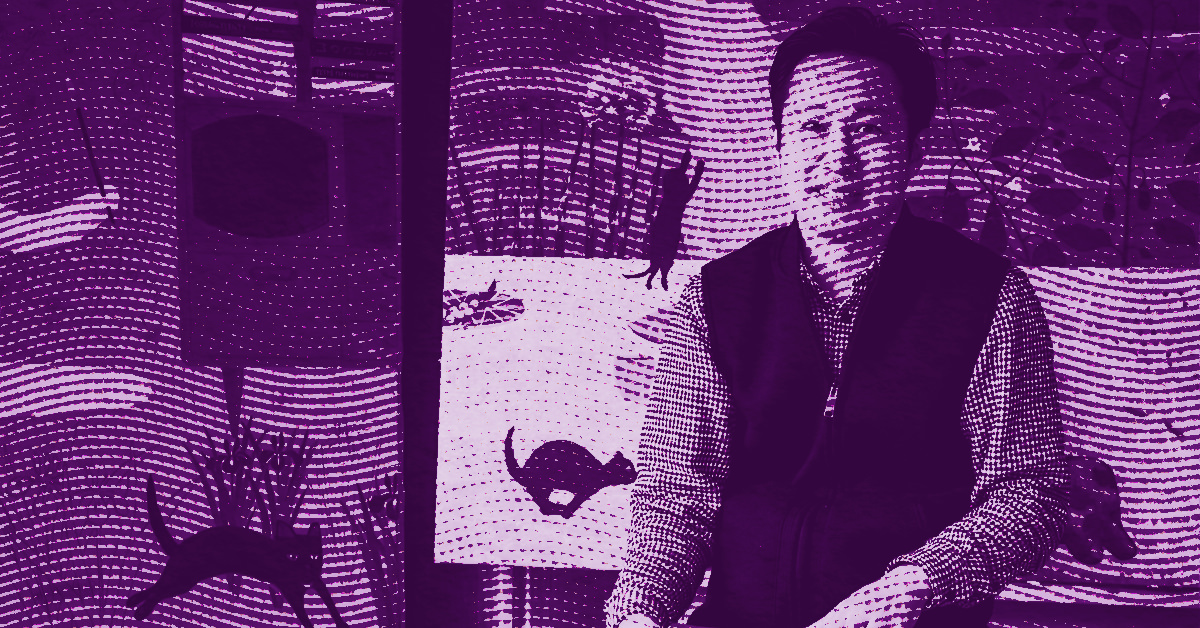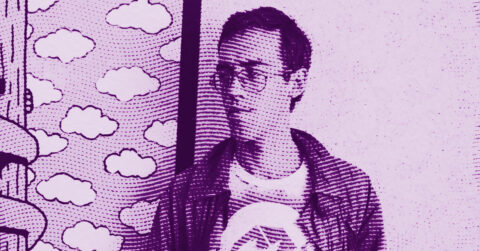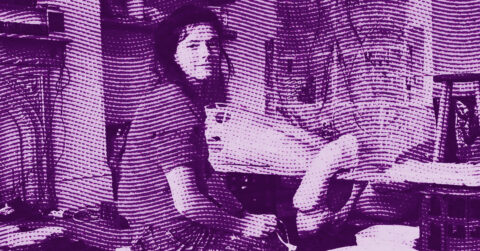Listen to me carefully, you bunch of snobs. Atsushi Kaga is not an artist who can be easily categorized in the neatly organized shelves of contemporary art. Born in Tokyo in 1978, this man chose voluntary exile in Ireland at nineteen to escape the stifling conventions of his native society, and this foundational decision still informs every brushstroke, every melancholic gaze of his anthropomorphic characters today. His artistic journey, nourished by this dual Japanese-Irish cultural belonging, reveals a work of rare psychological complexity, where the apparent simplicity of forms hides a deep meditation on identity, belonging, and the modern human condition.
Kaga’s visual universe revolves around recurring characters: Usacchi, this rabbit with an impassive expression who functions as his artistic alter ego, Kumacchi the one-legged bear, and a menagerie of anthropomorphic animals evolving in fantastic landscapes tinged with bittersweet melancholy. These creatures, far from being mere borrowings from manga culture, constitute an original plastic vocabulary that allows the artist to explore the intimate territories of the contemporary soul. Kaga himself describes his work as posing “banal questions to which there are no particular answers,” a phrase that perfectly summarizes the philosophical ambition of his approach.
This apparent formal simplicity actually masks a complex narrative construction, nourished by the experience of exile and uprooting. Ireland, Kaga’s adopted land for more than twenty years, has profoundly marked his artistic sensitivity. Irish humor, the capacity to find laughter in the darkest situations, permeates his canvases with a tender irony that tempers the existential darkness of his subjects. His characters speak Japanese while drinking pints of Guinness, embodying this cultural hybridization which constitutes one of the dramatic springs of his work.
The legacy of Samuel Beckett: the absurd as an existential condition
The work of Atsushi Kaga maintains a disturbing affinity with the universe of Samuel Beckett [1], that other exile who made Dublin his creative adopted land. Like Beckett’s protagonists, Kaga’s characters evolve in a world whose meaning seems constantly deferred, where waiting and uncertainty constitute the only certainties. This affinity is no coincidence: Ireland, through its tumultuous history and literary tradition marked by the absurd, has profoundly influenced the worldview of the Japanese artist.
Beckett’s influence first manifests in the construction of pictorial space in Kaga’s work. His landscapes, often barren and indeterminate, recall the non-places of Waiting for Godot or Happy Days. In works like “The World Will Not End Tomorrow” (2024), Usacchi stands on a tree stump amid a mountainous landscape that evokes the desolate expanses of Beckett’s theater. This staging of existential solitude, where the character seems to await an event that will never come, expresses a metaphysical anguish that permeates all of Kaga’s work.
More deeply, it is in the treatment of time that the kinship with Beckett becomes striking. In the Irish author’s work, time does not progress: it stagnates, repeats, goes in circles. Kaga’s characters seem caught in a similar temporality, frozen in suspended moments where narrative action gives way to melancholic contemplation. This temporal stagnation is visually expressed through the recurrence of motifs and situations: Usacchi appears in various contexts but his posture invariably remains that of waiting, silently observing a world whose meaning escapes him.
Humor is another essential point of convergence between the two creators. Beckett uses dark, biting humor that reveals the absurdity of the human condition. Kaga develops a softer but no less effective irony, mixing references to popular culture with existential reflections. His characters can express philosophical doubts while evolving in trivial situations, creating a comic disconnect that never excludes compassion. This humorous mode allows addressing the most serious questions without sinking into pathos, a lesson directly inherited from the Irish tradition embodied by Beckett.
Language itself becomes an artistic issue for both creators. Beckett, a bilingual writer, explored the expressive possibilities of creative bilingualism. Kaga, trained at the Dublin College of Art and Design, develops a form of visual bilingualism that mixes Japanese and Western codes. His characters speak Japanese in an Irish cultural environment, creating a linguistic hybridization that reflects the identity complexity of the artist in exile. This creative strategy allows exploration of the zones of identity uncertainty generated by the migratory experience, a central theme of artistic modernity.
Beckett’s influence culminates in the treatment of failure as artistic material. For Beckett, art arises from the impossibility of expressing, from the failure of communication. Kaga transposes this aesthetics of failure into the visual register: his characters are often depicted in situations of powerlessness or distress, but it is precisely this vulnerability that generates artistic emotion. Failure thus becomes a mode of understanding the world, a way of apprehending the complexity of contemporary reality.
Melancholy according to Dürer: the artist facing creation
The reference to Melencolia I by Albrecht Dürer [2] naturally presents itself when observing the recent evolution of Kaga’s work, especially since his move to Kyoto in 2018. Like Dürer’s pensive angel, the Japanese artist’s characters seem inhabited by this creative melancholy that characterizes the modern artist confronted with the limits of his art and the mysteries of inspiration.
This Dürer melancholy first manifests itself in the iconography of Kaga’s recent works. In paintings like “It always comes; a solace in the cat” (2021), one finds that atmosphere of contemplative meditation that bathes Dürer’s engraving. Kaga’s anthropomorphic animals adopt meditative postures, their gaze turned towards an invisible horizon, embodying this productive melancholy which, according to medieval humor theory, characterizes the artistic temperament. This posture is not accidental: it reflects the contemporary artist’s position facing the heritage of art and the challenges of modern creation.
The influence of Melencolia I is also evident in the treatment of pictorial space. Dürer organizes his image around symbolic objects that evoke the arts and sciences: geometric instruments, hourglass, scales. Kaga develops a personal iconography that is no less meaningful: his giant brushes, his references to popular culture, his symbolic landscapes constitute a visual vocabulary that questions the nature of contemporary artistic creation. In “Feet on the Ground, Please” (2024), a bronze sculpture depicting Usacchi holding an oversized brush, the Japanese artist directly dialogues with Dürer’s legacy: the artist’s tool becomes an identity attribute, a symbol of an assumed creative condition.
Kaga’s melancholy is enriched with an autobiographical dimension that echoes Dürer’s concerns. The German Renaissance artist explored in his engraving the tensions between divine inspiration and human technique, between creative genius and material limits. Kaga transposes these questions into the contemporary context of the globalized artist: how to maintain creative authenticity in a world dominated by the cultural industry? How to preserve artistic singularity in the face of the homogenization of forms? These questions are reflected in his recent works, where references to the Japanese pictorial tradition (influence of Jakuchu, the Rinpa school) coexist with borrowings from Western popular culture.
Melancholic temporality constitutes another point of convergence between the two artists. For Dürer, melancholy is linked to the acute awareness of passing time, symbolized by the hourglass and the bell. Kaga develops a similar temporality in his narrative cycles: Usacchi ages imperceptibly throughout the works, seasons succeed one another in his landscapes, but this evolution remains marked by a form of nostalgia that colors the whole oeuvre with a melancholic patina. This melancholy is not paralyzing: on the contrary, it becomes a creative engine, a way to poetically inhabit the world.
The technical aspect of Dürer’s melancholy also finds its translation in Kaga. The Japanese artist claims a handcrafted approach to painting, working alone in his studio, favoring creative intimacy over the constraints of industrial production. This fidelity to the traditional practice of art, in a context where many artists delegate execution to assistants, testifies to a productive melancholy that makes the act of painting a gesture of cultural resistance. Like Dürer’s angel surrounded by his instruments, Kaga claims the technical dimension of his art, refusing the contemporary dematerialization of artistic creation.
Art as an existential refuge
Kaga’s work reveals a conception of art as a territory of freedom in an increasingly constrained world. His characters evolve in indeterminate spaces that escape the logics of profitability and efficiency governing our contemporary societies. This utopian dimension of his work takes on a particular resonance at a time when artists must constantly justify the social utility of their practice.
The recent installation at the Maho Kubota Gallery in Tokyo, “While I am touching the sleeping cat, I feel as if I know you were there” (2024), perfectly illustrates this conception of art as a refuge. The artist reconstructs a traditional Japanese domestic space, with tatamis and natural wooden beams, creating an intimate environment that contrasts with the surrounding urban bustle. This staging reveals a nostalgia for traditional craftsmanship and pre-industrial rhythms of life, an aspiration to regain a human temporality in an accelerated world.
The recurrence of the motif of sleep in Kaga’s recent work (“Rest with us in Peace”, “The sleeping cat”) reflects this search for suspended time, a pause in the incessant flow of contemporary information and stimulation. His sleeping characters do not escape reality: they dream it, transform it, and reinvent it. This aesthetic of creative rest opposes contemporary hyperactivity and offers a contemplative alternative to modern agitation.
The recent evolution of Kaga towards a more stripped-down painting style, influenced by his rediscovery of traditional Japanese art during his relocation to Kyoto, bears witness to an artistic maturation that refuses the ease of immediate seduction. His recent canvases demand a time of contemplation, a mental availability that contrasts with the rapid consumption logics dominating the contemporary art market. This aesthetic demand constitutes a form of cultural resistance, an affirmation of the necessity for slow art in an age of speed.
The Parisian residency at the Irish Cultural Centre, where the artist currently resides, confirms this orientation. Far from the commercial stakes of artistic metropolises, Kaga develops a more introspective practice, more attentive to the subtleties of emotion and sensation. This geography of creative exile reveals an understanding of art as a territory of freedom, a space where the artist can develop a personal vision of the world without compromise with market expectations.
Kaga’s humor, inherited from the Irish tradition, makes it possible to address these serious issues without excessive solemnity. His recent works blend existential gravity with playful lightness, creating a tonal balance that characterizes the great works of contemporary art. This humorous modality allows him to reach a wide audience without sacrificing the complexity of his message, achieving the difficult synthesis between artistic rigor and cultural accessibility.
The political dimension of his work remains implicit but real. By choosing to depict vulnerable characters in a hostile world, Kaga develops a social critique that does not say its name. His anthropomorphic animals, confronted with the difficulties of modern existence (loneliness, precariousness, and disenchantment for example), embody the fragilities of the contemporary condition with an empathy that already constitutes a form of artistic commitment.
This recent evolution confirms the singularity of an artistic journey that refuses the ease of commercial success to deepen a demanding personal research. Atsushi Kaga thus asserts himself as one of the most original voices of his generation, capable of reconciling cultural heritage and creative modernity in a remarkably coherent work.
- Samuel Beckett, Waiting for Godot, Éditions de Minuit, 1952
- Albrecht Dürer, Melencolia I, copper engraving, 1514, kept at the Metropolitan Museum of Art, New York
















